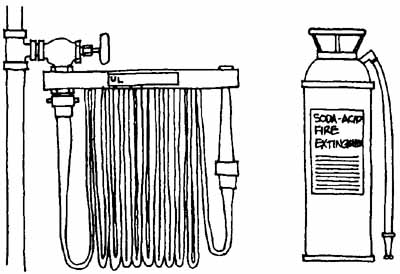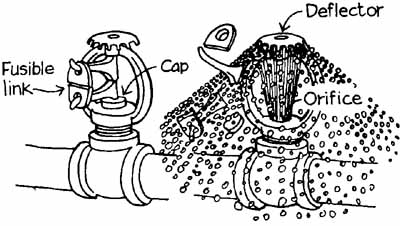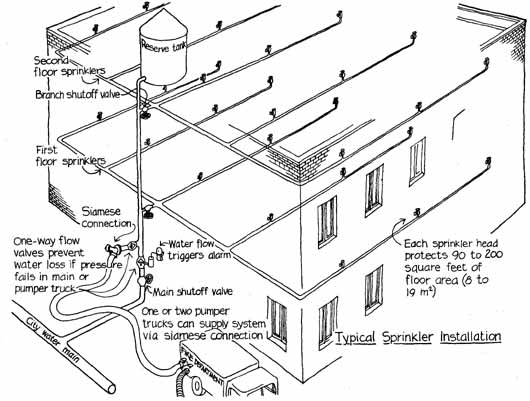Rapidly quenching a small fire before it can grow large is an effective way of preventing its spread. Such “first-aid” devices as portable extinguishers and fixed hose reels that can be used by building occupants help put out many small building fires before they can spread. Building codes require that these devices be provided and clearly identified (ill. 11 below). More reliable and effective are automatic sprinkler systems, in which each sprinkler head is controlled by a plug or link of fusible metal that melts at a temperature of about 150 degrees F (65 degrees C) (see ill. 12, ill. 13 below). So efficient is the resulting spray of water in extinguishing a fire that rarely do more than one or two sprinkler heads open before the fire is put out. Sprinkler systems are costly to install, but the initial expense is often balanced by cost savings that accrue to the building owner because of the presence of sprinklers. Building codes commonly allow several important concessions to a sprinklered building:
• Greater distances between exits are permitted in sprinklered buildings, which may have the effect of eliminating one or more exit stairways from a large building.
• Larger floor areas are permitted between fire separations in sprinklered buildings, which may result in the elimination of some fire-resistant walls and doors.
• Larger overall building areas and greater overall heights are permitted for sprinklered buildings.
• A lesser degree of fire protection may be permitted on some structural elements of a sprinklered building.
• Larger amounts of combustible building materials may be incorporated into a sprinklered building.
For the occasional building in which sprinkler water would cause irreparable damage to the building contents—a library, a museum, an art gallery—analogous but more expensive systems are available that discharge inert gases or powders onto the flames. Non-water systems also are useful in areas such as commercial kitchens where grease fires or other types of fires that can't be extinguished by water may break out.

ill. 11: Your building codes may require “first-aid” devices, like portable
extinguishers, and fixed-hose reels.

ill. 12: Fusible link with cap; and Deflector with orifice.

ill. 13: Typical Sprinkler Installation: Each sprinkler
head protects 90 to 200 sq. feet of floor area (8 to
19 sq. meters); Reserve tank; Second Floor Sprinklers; First Floor Sprinklers;
Siamese connection; One-way flow valves prevent water loss if pressure
fails in main or pumper truck; city water main; water flow triggers alarm
main shutoff valve; one or two pumper trucks can supply system via Siamese
connection; fire department.
Previous: Keeping Fire from Spreading Next: Protecting Human Lives